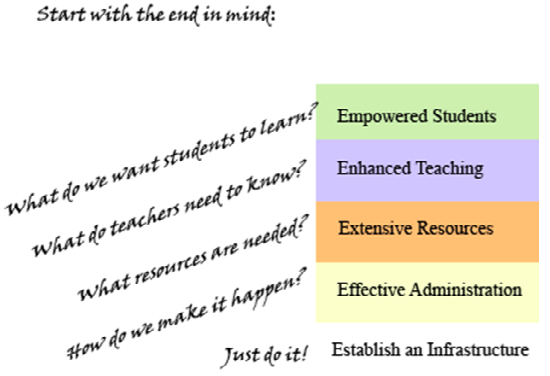
Planning for the last mile not the first
 In November I learned a valuealbe lesson. My wife and I were getting ready to run a 12K race in Vancouver, WA. The weather forecast called for high 30s to low 40s and rain the day of the race. It’s the Pacific Northwest so rain is always likely. I packed running clothes that I thought would be right for the race and the weather.
In November I learned a valuealbe lesson. My wife and I were getting ready to run a 12K race in Vancouver, WA. The weather forecast called for high 30s to low 40s and rain the day of the race. It’s the Pacific Northwest so rain is always likely. I packed running clothes that I thought would be right for the race and the weather.
The day of the race we woke up to cloudy…but not rainy skies and tempatures in the mid to upper 40s. I decided that I would stick to my plan and wear what I brought. As you can see from the picture that included a rain proof jacket plus a cold weather long sleeve shirt and a running shirt.Â
My wife warned me I would be to warm, but of course I didn’t listen to her advice (why should I, she runs faster and farther than I do). When we stepped outside the hotel I felt comfortable not to hot, not to cold. My wife on the other hand was a bit cold…huh….who’s laughing now?
The race started and not 3K in I started getting a good sweat going. My muscles loosened up and I found my stride. By the 6th Kilometer I was hurting. I was tired, soaking wet from sweat, as the rain jacket did what it was suppose to do and keep my heat in. I was dying to keep up with my wife (which is always my goal…I’ve yet to beat her in a race…2014 is my year though!)
My wife on the other hand was feeling great..she went from a bit cold to nice and warm and perfectly dressed for the race. Needless to say by the 8th Kilometer I was pealing off layers trying to cool down and get my energy back (with my wife running backwards a few steps ahead of me egging me on…..wish I was making that up).
I did finish…in a t-shirt and plenty warm.
Planning for the end not the beginning
As I was running this blog post starting rolling around in my head (I write a lot of blog posts while running….I need to get better at actually writing them down). I made a common mistake. I planned for the beginning of the run not the end of the run. It’s the same thing I see happen with technology plans or with laptop/tablet roll out programs.
All to often I see school districts plan and overplan for the beginning of the roll out or the impact the new technology might have and less time on what happens next.
It is the problem we all face with technology plans. We make a plan based on the data we have, we prepare to implement the plan and even when things (like the weather) around us change we stick to the plan thinking we have to. Technology moves way to fast to “stick to the plan”. Technology plans need to be simple, lightweight, and easily changeable. Otherwise you find yourself half way through trying to peel off layers and keep the momentum going.
We talk a lot in education about the “Backwards By Design” model of lesson planning. A method I used in the classroom, we still use in COETAIL and most other planning I do.
Yet I don’t find it much in creating technology plans.
What does learning look like in 3 years time?Â
 When creating plans with admin teams and school districts I like to start with this simple sentence. Not what technology does everyone have, not what do we need….but rather what does it look like. From there we talk about the skills that we hope student will learn. This isn’t a new notion. I wrote about this process in 2007 in this free PDF you can download from the front of my blog.
When creating plans with admin teams and school districts I like to start with this simple sentence. Not what technology does everyone have, not what do we need….but rather what does it look like. From there we talk about the skills that we hope student will learn. This isn’t a new notion. I wrote about this process in 2007 in this free PDF you can download from the front of my blog.
It’s a paper I still use today with teams. The tools have changed the idea of in sourcing to outsorcing has changed (unless you are in China…which is where I was when I wrote this…and it still applies) but the idea of starting with the question of “What do we want students to learn?” and working backwards from there is still an important one to start with.
What happens when you don’t start with the end in mind is something that I’m starting to see a lot of (and we’ll see if this holds true for 2014). It is the questions that is asked after every students has an iPad or a laptop or both.
Now what?
Getting the technology into the students’ hands really is the easiest part of the process. Rethinking learning, rethinking teaching, rethinking the classroom structure, the value of content vs process, are the really hard parts. They are the parts at the end of the plan that many times are overlooked because they aren’t tangelable. They aren’t shinny and new, but they are more important.
Refuel Stations
 The only thing that saved me that last race was that about 9 Kilometers in when I was really struggling there was an refueling station. My wife pushed an energy gel pack in my hand and a cup of gatoraid. A half a kilometer later I felt it kick in, got my energy back and finished the race pretty strong (my time splits to the right thanks to runkeeper).
The only thing that saved me that last race was that about 9 Kilometers in when I was really struggling there was an refueling station. My wife pushed an energy gel pack in my hand and a cup of gatoraid. A half a kilometer later I felt it kick in, got my energy back and finished the race pretty strong (my time splits to the right thanks to runkeeper).
There is nothing wrong with using refueling stations. In technology plans these can be sending teachers to conferences, bringing in a consultant, or having a renewed technology focus. We need to be refueled in our passion and our beliefs of why we do what we do and where we expect this new learning to take us. Many times I get the sense that schools and districts feel like they have to go it alone as if asking for help is a sign of weakness or unpreparedness.
Building this into a technology plan and revisiting it helps. You don’t always know where you need a refueling stating. Is it 1 year in? Is it 3 years in? However having the option to have one is what matters. A team, much like a runner, can tell you when the refueling is needed. Be flexible, be open to opportunities and if someone pushes an energy gel pack in your hand…take it.
We make planning many times more difficult than it needs to be. It’s a pretty simple formula really. Start with the end in mind, be willing to adjust your plan when things change, use refueling stations and listen to your wife those around you.







A good reminder about the need to plan adequately and long-term. Sometimes schools neglect to properly budget for the software/apps needed to really make the technology useful. Maintenance costs can be underestimated. And as pointed out in the posting, proper training (particularly long-term) is neglected. Refueling stations are a necessity. It is best if staff members can self-determine their needs (frequency, type), but sometimes leadership must step in to ensure long-term goals are achieved.
This is a great story and I’m pretty sure I won’t be able to do another run (not that I run that much) without thinking of your story and your lesson that men need to always listen to their wives, er-um—We need to plan for the finish and not just the start!
I intensely dislike being cold (It might have to do with growing up in Canada and standing at the bus stop at -25 C/ -13 F waiting for forty five minutes or more because the bus was stuck in traffic due to the snow, or it had broken down…) I wear a long-sleeve at the beginning of my run that I can take off and wrap around my waist when I get too hot. So, I plan for flexibility.
It also helps to have someone at the side-line who’ll take that jacket off of you. 🙂
Hey Jeff, This is just what I need to here right now. I am in the beginnings of my unit and I am getting stuck with the details and losing what does the end need to look like. I think when talking with teachers about using tech in their classrooms this is a good place to start and then show them how there are many paths (tech) to that end result.
Jeff, this is such a relevant post for me as the school is ordering “tech” for next year. Every single department is asking for iPads, either adding to what they currently have or for the first time. One such department is the World Language Department which is a great group of hard working teachers here. Now, my first question was, “What are you going to use them for?” Well, I know there are some good language apps that students like but I’m not sure they will work in our class…my friends said they use them and the kids really like it….I know it engages the students….So, in the end they were not sure what they were going to use the iPad for but they know they want to use them. Your post reminds us that we have to start with the end in mind – what is the learning objective? It sounds straightforward but getting the answer takes some deep thinking and re-engineering of units – sometimes a difficult task for teachers who are trying to integrate tech. We all want tech and we all want teachers to use tech with our students but we have to continue to ask the question, What do we want our students to learn?
[…] for the last mile, not the first. Post by Jeff […]